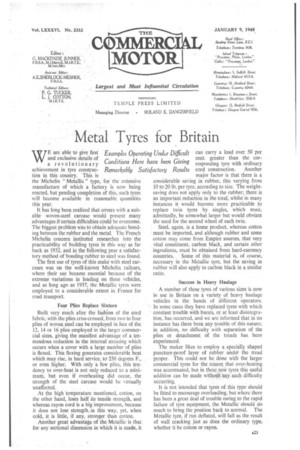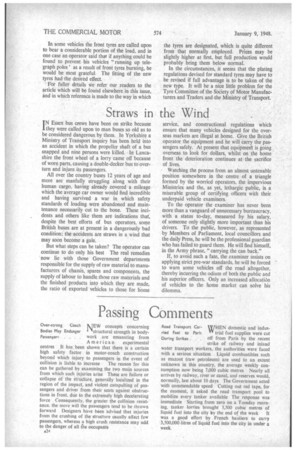Metal Tyres for Britain
Page 25

Page 26

If you've noticed an error in this article please click here to report it so we can fix it.
WE are able to give first and exclusive details of a revolutionary achievement in tyre construction in this country. This is the Michelin "Metallic "• type, for the extensive manufacture of which a factory is now being erected, but pending completion of this, such tyres will become available in reasonable quantities this year.
It has long been realized that covers with a suitable woven-steel carcase would present many advantages if Certain difficulties could be overcome. The biggest problem was to obtain adequate bonding between the rubber arid the metal. The French Michelin concern instituted researches into the practicability of building tyres in this way as far back as 1932, and in the following year a satisfactory method of bonding rubber to steel was found.
The first use of tyres of this make with steel carcases was on the well-known Michelin railcars, where their use became essential because of the extreme variations in loading on these vehicles, and as long ago as 1937, the Metallic tyres were employed to a considerable extent in France for road transport.
Four Plies Replace Sixteen Built very much after the fashion of the cord fabric, with the plies criss-crossed, from two to four plies of woven steel can be employed in lieu of the 12, 14 or 16 plies employed in the larger commercial sizes, giving the manifest advantage of a tremendous reduction in the internal stressing which occurs when a cover with a large number of plies is flexed. This flexing generates considerable heat which may rise, in hard service, to 250 deerees F., or ellen higher. With only a few plies, this tendency to over-heat is not only reduced to a minimum, but even if overheating did occur, the strength of the steel carcase would be virtually unaffected.
At the high temperature mentioned, cotton, on the other hand, loses half its tensile strength, and whereas rayon cord is a big improvement, because it does not lose strength, in this way, yet, when cold, it is little, if any, stronger than cotton.
Another great advantage of the Metallic is that for any sectional dimension in which it is made, it • can carry a load over 50 per cent. greater than the corresponding tyre with ordinary cord construction. Another major factor is that there is a considerable saving in rubber, this varying from 10 to 20 lb. per tyre, according to size. The weightsaving does not apply only to the rubber; there is an important reduction in the total, whilst in many instances it would become more practicable to replace twin tyres by singles, which must, admittedly, be somewhat larger but would obviate the need for the second wheel of each twin.
Steel, again, is a home product, whereas cotton must be imported, and although rubber and some cotton may come from Empire sources, that very vital constituent, carbon black, and certain other ingredients, must be obtained from hard-currency countries. Some of this material is, of course, necessary in the Metallic tyre, but the saving in rubber will also apply to carbon black in a similar ratio.
Success in Heavy Haulage A number of these tyres of various sizes is now in use in Britain on a variety of heavy haulage vehicles in the hands • of different operators. In some cases they have replaced tyres with which constant trouble with bursts, or at least disintegration, has occurred, and we are informed that in no instance has there been any trouble of this nature; in addition, no difficulty with separation of the plies or detachment of the treads has been experienced.
The maker likes to employ a specially shaped puncture-proof layer of rubber under the tread proper. This could not be done with the larger commercial tyres for the reason that over-heating was accentuated, but in these rieW tyres this useful addition can be made without any such difficulty occurring.
It is not intended that tyres of this type should be fitted to encourage overloading, but where there has been a great deal of trouble awing to the rapid failure of tyre equipment, the Metallic should do much to bring the position back to normal. The Metallic tyre, if run deflated, will fail as the result of wall cracking just as does the ordinary type, whether it be cotton or rayon. In some vehicles the front tyres are called upon to bear a considerable portion of the load, and in one case an operator said that if anything could be found to prevent his vehicles "running up telegraph poles' as a result of front tyres bursting, he would be most grateful_ The fitting of the new tyres had the desired effect.
For fuller details we refer our readers to the article which will be found elsewhere in this issue, and in which reference is made to the way in which the tyres are designated, which is quite different from that normally employed. Prices may be slightly higher at first, but full production would probably bring them below normal.
In the circumstances, it seems that the plating regulations devised for standard tyres may have to be revised if full advantage is to be taken of the new type. It will be a nice little problem for the Tyre Committee of the Society of Motor Manufacturers and Traders and-the Ministry of Transport.




























































































